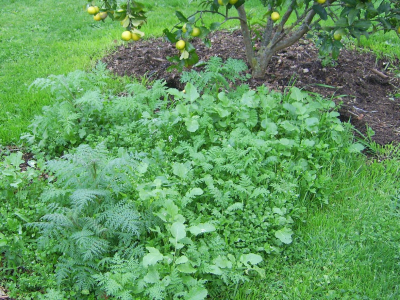
List of dynamic accumulators
 Once you know the
shortcomings of your soil, you can start planning green manures,
mulches, and herbal leys to correct deficiencies. All three of
these fertility campaigns are built around dynamic
accumulators ---
plants that concentrate micro and macronutrients from the soil into
their leaves, stems, and roots. Robert Kourik's book seems to be
the source of most of the data in more current books and websites about
dynamic accumulators, and once again I compiled the most useful species
into a dynamic accumulator
spreadsheet.
Once you know the
shortcomings of your soil, you can start planning green manures,
mulches, and herbal leys to correct deficiencies. All three of
these fertility campaigns are built around dynamic
accumulators ---
plants that concentrate micro and macronutrients from the soil into
their leaves, stems, and roots. Robert Kourik's book seems to be
the source of most of the data in more current books and websites about
dynamic accumulators, and once again I compiled the most useful species
into a dynamic accumulator
spreadsheet.
Looking for a
calcium-rich plant to help harden your chicken's eggshells? Why
not grow some comfrey or dandelions. Need to boost the nitrogen
content of low fertility soil? Clovers and vetches are hard to
beat, but you might also be able to gather high nitrogen tobacco-stalks
from your tobacco-growing neighbors.
All summer, as I dragged
our heaviest chicken tractor up and down a steep hill in the mule
garden, I've been considering planting a dynamic accumulator patch
there to be mowed at intervals, providing fertility to nearby garden
beds. It turns out that this concept has a formal name --- an
herbal ley. The term herbal ley technically refers to a pasture
of mixed grasses, legumes, and herbs, but I see no reason why I can't
use a similar patch to feed my darling fruit trees and
vegetables. I'll be playing with my dynamic accumulator
spreadsheet this winter to come up with a mixture of plants that
provides a well-rounded assortment of nutrients.
This post is part of our lunchtime series reviewing Robert Kourik's Designing and Maintaining your
Edible Landscape Naturally.
Read all of the entries:
|
Want more in-depth information? Browse through our books.
Or explore more posts by date or by subject.
About us: Anna Hess and Mark Hamilton spent over a decade living self-sufficiently in the mountains of Virginia before moving north to start over from scratch in the foothills of Ohio. They've experimented with permaculture, no-till gardening, trailersteading, home-based microbusinesses and much more, writing about their adventures in both blogs and books.
Want to be notified when new comments are posted on this page? Click on the RSS button after you add a comment to subscribe to the comment feed, or simply check the box beside "email replies to me" while writing your comment.
